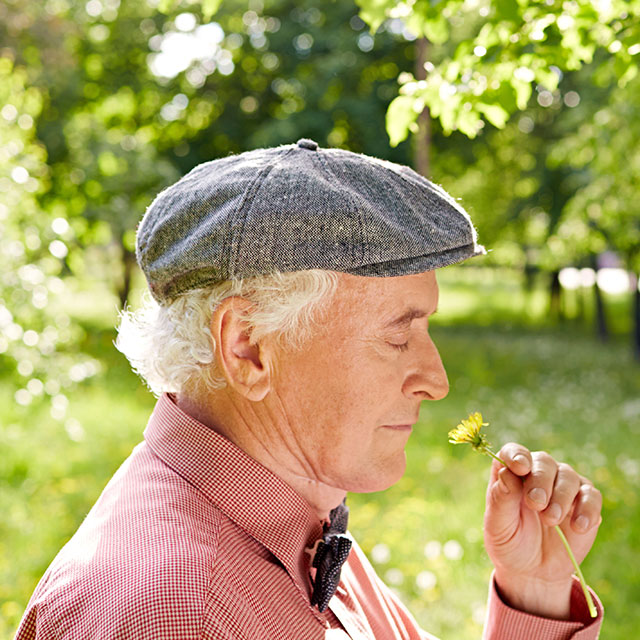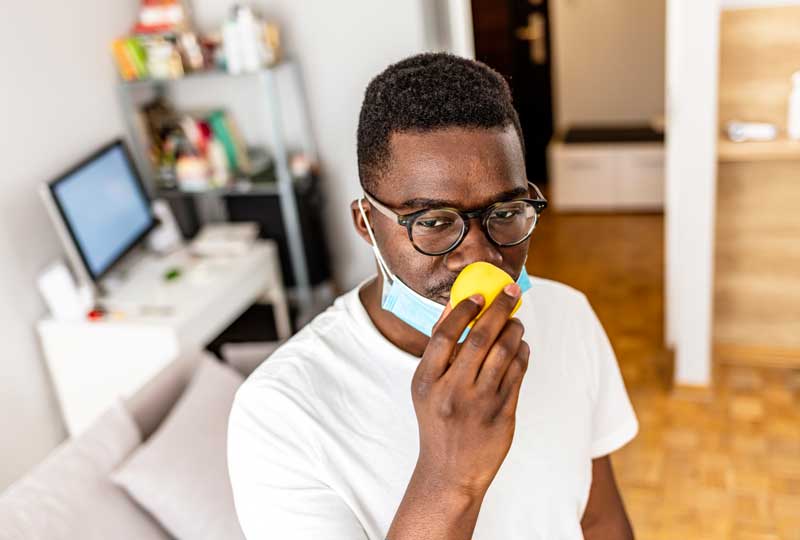Vanderbilt’s Smell and Taste Center is one of a handful of clinics in the country that’s geared toward those experiencing smell dysfunction. Here’s what causes loss of smell — and when you might want to consider evaluation.
If you’ve never experienced loss of smell — what’s known clinically as hyposmia — you likely never gave it much thought.
Then came the COVID-19 pandemic.
It’s not that hyposmia never existed before. In fact, there are a handful of smell and taste clinics, which diagnose and treat smell and taste disorders, in the U.S. — one of which is at Vanderbilt University Medical Center.
“Post-viral olfactory loss or smell loss is something that’s existed for as long as I’ve been in clinical practice,” said Justin Turner, M.D., of the Vanderbilt Vanderbilt Smell and Taste Center. “But what we’re seeing with COVID-19 is this sort of secondary pandemic: large numbers of people with, in some cases, permanent smell dysfunction who are seeking care.”
Though it’s hard to get an accurate picture of how many COVID-19 patients will experience smell loss (and subsequent taste dysfunction), objective assessments suggest that the number hovers around 70-80% of patients. Of that number, it’s estimated that around 80% will regain their sense of smell by about 6-8 weeks post infection. “The bad news is that that leaves another 20% who will not recover — which wouldn’t be a ton of people if it was an uncommon viral illness,” Turner said. “But when you talk about something that at this point has infected hundreds of millions of people, we’re really talking about a whole new demographic who is going to be dealing this problem for the long term.”
So what causes smell loss? And is there anything that can be done about it? Turner answers our questions below.
Who experiences smell loss?
In general, smell loss can be categorized into three groups, said Turner. The first group is those who experience smell loss post-virally, after having an upper-respiratory infection.
The second group is people who have suffered some type of trauma, such as head trauma or a central nervous system injury. Those in this group are more likely to have permanent smell dysfunction.
The third and most common group are older patients, who experience a more prolonged and progressive loss of smell. In general people begin to experience a decline in their smell function around age 50, progressing from that point forward. “If it comes on more suddenly or rapidly,” said Turner, “it could be indicative of neurodegenerative disease, like Alzheimer’s or Parkinson’s.”
Why does COVID-19 cause loss of smell?
“In the top of the nasal cavity there are neurons — it’s one of the few places in the body where neurons or brain cells are exposed to the external environment,” Turner explained. “As you breathe in different odorants, they go up to those neurons and that’s how you detect smells. What we think happens in post-viral smell loss is that the inflammatory insult from that virus causes some of those neurons to die off.”
In the case of COVID-19 smell loss, researchers believe that it’s the sustentacular cells — the cells next to the neurons that provide them with nourishment — that are affected. When the neurons lose their metabolic support, they die, reducing your ability to detect odors.
Is there a treatment for loss of smell?
“Unfortunately, in most cases there, there’s not a whole lot that you can do in terms of therapeutics. There are no FDA-approved drugs for the treatment of smell loss, and your ability to recover your sense of smell or any sort of interventional strategies with respect to the sense of smell are highly dependent on the timing of smell loss,” Turner said. “So we like to see people early in the process, within a few weeks or months of losing their sense of smell. And the reason for that is that they’re likely in a window where there is still potential for recovery or regeneration of that smell function.”
One of the hyposmia treatments available in that window is steroids, Turner explained — either systemic or topical steroids that are delivered into the nose via spray or drops. Another way to treat loss of smell is smell training, or olfactory training, which is a process whereby you expose the patient to certain odorants on a repeated basis over a period of time. This helps to bolster the connection between the nasal-cavity neurons and the central nervous system.
When should a COVID-19 patient consider making an appointment at the Smell and Taste Center for evaluation?
Most people will get their smell and taste back by around 6 weeks after COVID-19 infection; therefore, Turner recommends allowing some time for that spontaneous improvement. But after two months, if you still have significant smell loss, and it doesn’t seem to be improving, consider making the call.
“If you can tell there’s a progressive change — maybe your smell isn’t what it was but is getting better — that’s a positive indicator,” Turner said. “But if it doesn’t appear to be getting better after 8 weeks, that’s when we’d like to get you into the clinic for evaluation.”

Help with smell and taste disorders
The Smell and Taste Center at Vanderbilt University Medical Center is a leading destination for people with smell and taste disorders. The center’s experts evaluate to learn how extensive each patient’s disorder is and to rule out underlying medical conditions that could be affecting senses of smell and taste.

